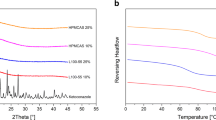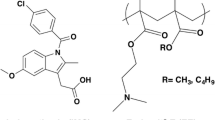Abstract
Purpose
To investigate the structural effect of polymeric excipients on the behavior of free volume of drug-polymer dispersions in relation to glass transition.
Methods
Two drugs (indomethacin and ketoconazole) were selected to prepare amorphous dispersions with PVP, PVPVA, HPC, and HPMCAS through spray drying. The physical attributes of the dispersions were characterized using SEM and PXRD. The free volume (hole-size) of the dispersions along with drugs and polymers was measured using positron annihilation lifetime spectroscopy (PALS). Their glass transition temperatures (Tgs) were determined using DSC and DMA. FTIR spectra were recorded to identify hydrogen bonding in the dispersions.
Results
The chain structural difference-flexible (PVP and PVPVA) vs. inflexible (HPC and HPMCAS)-significantly impacts the free volume and Tgs of the dispersions as well as their deviation from ideality. Relative to Tg, free volume seems to be a better measure of hydrogen bonding interaction for the dispersions of PVP, HPC, and HPMCAS. The free volume of polymers and their dispersions in general appears to be related to their conformations in solution.
Conclusions
Both the backbone chain rigidity of polymers as well as drug-polymer interaction can impact the free volume and glass transition behaviors of the dispersions.






Similar content being viewed by others
References
Friesen DT, Shanker R, Crew M, Smithey DT, Curatolo WJ, Nightingale JAS. Hydroxypropyl methylcellulose acetate succinate-based spray-dried dispersions: an overview. Mol Pharm. 2008;5:1003–19.
Yonemochi E. Estimation of physicochemical stability of the formulation using solid dispersion technique and its application for formulation design. Pharm Tech Jpn. 2010;26:661–6.
Laitine R, Lobmann K, Strachan CJ, Grohganz H, Rades T. Emerging trends in the stabilization of amorphous drugs. Int J Pharm. 2013;453:65–79.
Wegiel LA, Mauer LJ, Edgar KJ, Taylor LS. Crystallization of amorphous solid dispersions of resveratrol during preparation and storage-impact of different polymers. J Pharm Sci. 2013;102:171–84.
Paudel A, Humbeeck J, Van Den Mooter G. Theoretical and experimental investigation on the solid solubility and miscibility of naproxen in poly (vinylpyrrolidone). Mol Pharm. 2010;7:1133–48.
Rowe RC, Sheskey PJ, Weller PJ. Handbook of pharmaceutical excipients, 4ed London. UK: Pharmaceutical Press; 2003.
Tanno F, Nishiyama Y, Kokubo H, Obara S. Evaluation of hypromellose acetate succinate (HPMCAS) as a carrier in solid dispersions. Drug Dev Ind Pharm. 2004;30:9–17.
Sotthivirat S, McKelvey C, Moser J, Rege B, Xu W, Zhang D. Development of amorphous solid dispersion formulations of a poorly water-soluble drug, MK-0364. Int J Pharm. 2013;452:73–81.
Ueda K, Higashi K, Yamamoto K, Moribe K. The effect of HPMCAS functional groups on drug crystallization from the supersaturated state and dissolution improvement. Int J Pharm. 2014;464:205–13.
Al-Obaidi H, Lawrence MJ, Shah S, Moghul H, Al-Saden N, Bari F. Effect of drug-polymer interactions on the aqueous solubility of milled solid dispersions. Int J Pharm. 2013;446:100–5.
Matsumoto T, Zografi G. Physical properties of solid molecular dispersions of indomethacin with poly (vinylpyrrolidone) and poly (vinylpyrrolindone-covinyl-acetate) in relation to indomethacin crystallization. Pharm Res. 1999;16:1722–8.
Taylor L, Zografi G. Spectroscopic characterization of interactions between PVP and indomethacin in amorphous molecular dispersions. Pharm Res. 1997;14:1691–8.
Konno H, Handa T, Alonzo DE, Taylor LS. Effect of polymer type on the dissolution profile of amorphous solid dispersion containing felodipine. Eur J Pharm Biopharm. 2008;70:493–9.
Ilevbare GA, Liu H, Edgar KJ, Taylor LS. Maintaining supersaturation in aqueous drug solutions: impact of different polymers on induction times. Cryst Growth Des. 2013;13:740–51.
Qian F, Wang J, Hartley R, Tao J, Haddadin R, Mathias N, et al. Solution behavior of PVP-VA and HPMC-AS-based amorphous solid dispersions and their bioavailability implications. Pharm Res. 2012;29:2766–76.
Curatolo W, Nightingale JA, Herbig SM. Utility of hydroxypropylmethylcellulose acetate succinate (HPMCAS) for initiation and maintenance of drug supersaturation in the GI milieu. Pharm Res. 2009;26:1419–31.
Hiroshi F. Polymer solutions. Amsterdam: Elsevier; 1990.
Kamide K. Cellulose and cellulose derivatives: molecular characterization and its applications. San Diego: Elsevier; 2005.
Zhong YZ, Wolf P. Effect of hydrophobic unit and its distribution on solution properties of vinylpyrrolidone and vinyl acetate copolymers. J Appl Poly Sci. 1999;74:345–52.
Simha R, Weil C. Concerning free volume quantities and the glass temperature. J Macromol Sci-Phys. 1970;4:215–226.
Cohen MH, Turnbull D. Molecular transport in liquids and glasses. J Chem Phys. 1959;31:1164–9.
Bhardwaj SP, Arora KK, Kwong E, Templeton A, Clas SD, Suryanarayanan R. Correlation between molecular mobility and physical stability of amorphous itraconazole. Mol Pharm. 2013;10:694–700.
Simha R, Somcynsky T. On the statistical thermodynamics of spherical and chain molecule fluids. Macromolecules. 1969;2:342–50.
Prigogine I. The molecular theory of solutions. Amsterdam: North Holland Publishing Company; 1957.
Moulinié P, Utracki LA. Equation of state and free-volume content. In: Utracki LA, Jamieson AM, editors. Polymer physics: from suspensions to nanocomposites and beyond. Hoboken: Wiley; 2010. p. 227–82.
Wästlund C, Maurer FHJ. Positron lifetime distribution and free volume parameters of PEO/PMMA blends determined with the maximum entropy method. Macromolecules. 1997;30:5870–6.
Jamieson AM, Olson BG, Nazarenko S. Positron annihilation lifetime studies of free volume in heterogeneous polymer sytems. In: Utracki L, Jamieson AM, editors. Polymer physics: from suspensions to nanocomposites and beyond. Hoboken: Wiley; 2010. p. 473–522.
Fang Z, Xu Y, Tong L. Free-volume hole properties of two thermoplastic nanocomposite based on polymer blends probed by positron annihilation lifetime spectroscopy. J Appl Poly Sci. 2006;102:2463–9.
Utracki LA. Free volume in molten and glassy polymers and nanocomposites. In: Utracki L, Jamieson AM, editors. Polymer physics: from suspension to nanocomposites and beyond. Hoboken: Wiely; 2010. p. 553–604.
Dlubek G, Shaikh MQ, Rätzke K, Pionteck J, Paluch M, Faupel, F. Subnanometer size free volumes in amorphous verapamil hydrochloride: a positron lifetime and PVT study through Tg in comparison with dielectric relaxation spectroscopy. Euro J Pharm Sci. 2010;41:388–98.
Bartoš J, Šauša O, Bandzuch P, Zrubcová J, Krištiak J. Free volume factor in supercooled liquid dynamics. J Non-Cryst Solids. 2002;307–310:417–25.
Dai GH, Deng Q, Liu J, Shi H, Huang CM, Jean YC. Free-volume hole distribution of polymers by positron annihilation lifetime spectroscopy, Journal de Physique. IV, Colloque, C4 (4th International Workshop on Positron).1993; 233–239.
Sato M. Wormlike chain parameters of cellulose and cellulose derivatives. Polym J. 1983;15:213–23.
Taghizadeh MT, Foroutan M. A study on P(VP-VA) hydrophobically associating behavior of water-soluble copolymers. Iran Polym J. 2005;14:47–54.
Campbell JA, Goodwin AA, Ardi MS, Simon GP, Landry-Coltrain CJT. Free volume studies in miscible polymer blend systems. Macromol Symp. 1997;118:383–8.
Van den Mooter G, Wuyts M, Blaton N, Busson R, Grobet P, Augustijns P, et al. Physical stabilization of amorphous ketoconazole in solid dispersions with polyvinylpyrrolidone K25. Euro J Pharm Sci. 2001;12:261–9.
Zingone G, Moneghini M, Rupena P, Vojnovic D. Characterization and dissolution study of solid dispersions of theophylline and indomethacin with PVP/VA copolymers. S T P Pharm Sci. 1992;2:186–92.
Ford JL. The use of thermal analysis in the study of solid dispersions. Drug Dev Ind Pharm. 1987;13:(9):1741–77.
Kanaujia P, Lau G, Ng WK, Widjaja E, Hanefeld A, Fischbach M, et al. Nanoparticle formation and growth during in vitro dissolution of ketoconazole dolid dispersion. J Pharm Sci. 2011;100:2876–85.
Yamakawa H. Helical wormlike chains in polymer solutions. New York: Springer; 1997.
Kamide K, Saito M. Cellulose and cellulose derivatives: recent advances in physical chemistry. Adv Polym Sci (Biopolymers). 1987;83:1–57.
Tao SJ. Positronium annihilation in molecular substances. J Chem Phys. 1972;56:5499–510.
Eldrup M, Lightbody D, Sherwood NJ. The temperature dependence of positron lifetimes in solid pivalic acid. Chem Phys. 1981;63:51–8.
Eldrup M, Vehanen A, Schultz PJ, Lynn KG. Positronium formation and diffusion in a molecular solid studied with variable-energy positron. Phys Rev Lett. 1983;51:2007–10.
Kwei TK, Pearce EM, Pennacchia JR, Charton M. Correlation between the glass transition temperatures of polymer mixtures and intermolecular forces parameters. Macromolecules. 1987;20:1174–6.
Schneider HA, Di Marzio EA. The glass temperature of polymer blends: comparison of both the free volume and the entropy prediction with data. Polymer. 1992;16:3453–61.
Liu DS, Shen Q, Ding HG, Zhong L. Influence of the components on Tg of cellulose/poly(ethylene glycol) and model. Xianweisu Kexue Yu Jishu. 2006;14:40–45.
Acknowledgements and Disclosures
Authors would like to thank the management of Drug Product Science & Technology at Bristol-Myers Squibb for financial support as well as Prof. Nazarenko and Mr. Goetz of the University of Southern Mississippi for providing free volume and fractional free volume results used in this paper and supplying the experimental procedure used. In addition, authors are grateful to Dr. Hussain of Bristol-Myers Squibb for reading the manuscript.
Author information
Authors and Affiliations
Corresponding author
Appendix
Appendix
Specific Volume and Fractional Free Volume from P-V-T [24, 26]
After simplification, the SS equation of state can be expressed as the following:
Where a0 = 0.0921, a1 = 4.892, T*, P*, and V* are the conditions at the material’s critical point. The data shown is found using a Tate extrapolation to 0 MPa, allowing the reduction of the above equation to
Occupied volume, Vocc, was calculated using the following equation where yocc is the occupied fraction, \( \overset{\sim }{P},\overset{\sim }{T} \), and \( \overset{\sim }{V} \) are reduced parameters:
Fractional free volume, FFV, can be calculated using:
Rights and permissions
About this article
Cite this article
Li, J., Zhao, J., Tao, L. et al. The Effect of Polymeric Excipients on the Physical Properties and Performance of Amorphous Dispersions: Part I, Free Volume and Glass Transition. Pharm Res 32, 500–515 (2015). https://doi.org/10.1007/s11095-014-1478-0
Received:
Accepted:
Published:
Issue Date:
DOI: https://doi.org/10.1007/s11095-014-1478-0




